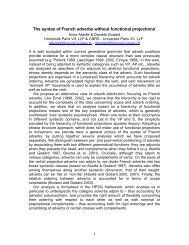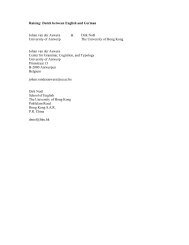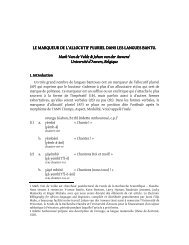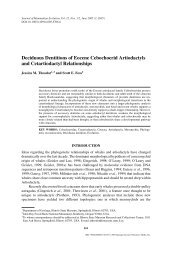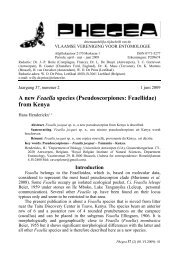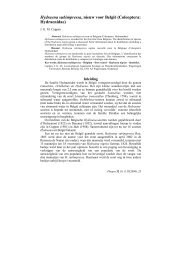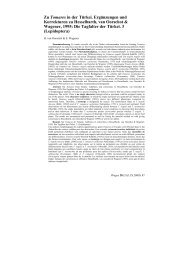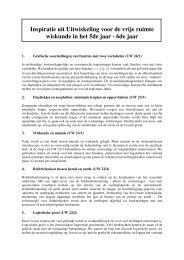Turtles as hopeful monsters
Turtles as hopeful monsters
Turtles as hopeful monsters
You also want an ePaper? Increase the reach of your titles
YUMPU automatically turns print PDFs into web optimized ePapers that Google loves.
What the papers say<br />
Figure 1. Schematic representation of the turtle carapace in<br />
dorsal view (A) and in a transverse section (B) (A: after A.F.<br />
Carr, Handbook of <strong>Turtles</strong>, Cornell University Press, 1952,<br />
Fig. 2c).<br />
shield, the shortening of the trunk, the immobilization of the<br />
dorsal vertebral column and a backwards shift of the pectoral<br />
girdle.<br />
This evolutionary scenario (10) not only requires that the<br />
turtle carapace be derived from a fusion of ancestral osteoderms,<br />
but also encounters the problem that there is no, or only<br />
a very minor, backward shift of the pectoral girdle in turtles. (11)<br />
Instead, the scapula of turtles comes to lie inside the rib cage<br />
because of a deflection of rib growth to a more superficial<br />
position. (12) Recent developmental work (1,13,14) h<strong>as</strong> identified<br />
inductive interaction generated by the carapacial ridge <strong>as</strong><br />
probable cause of this deflection of rib growth. Here is how it<br />
works.<br />
The vertebrate embryo is organized in three germ layers,<br />
the outer ectoderm, the inner entoderm, and the mesoderm<br />
between the two. During development, that part of the<br />
mesoderm lying alongside the notochord (paraxial mesoderm)<br />
becomes compartmentalized into segments, discrete blocks<br />
of cells or somites. From the somites originate, by embryonic<br />
cell proliferation and migration, the endoskeleton, the voluntary<br />
body musculature, and the dermis, the deep layer of<br />
the skin. The somites define the primary segmentation of the<br />
vertebrate body, which in the adult is still reflected in the<br />
segmented body musculature of fishes or salamanders, for<br />
example. To bend the body into a lateral curve during<br />
locomotion, the segmented body muscles must bridge the<br />
intervertebral joint. This means that the joint between<br />
vertebrae must lie within the primary body segments, which<br />
also allows the spinal nerves to exit between two vertebrae on<br />
their way to the body muscles. By that arrangement, the<br />
vertebral body itself, and the rib attached to it, come to lie in<br />
between the primary body segments. This repositioning of the<br />
vertebrae relative to the primary body segments is achieved by<br />
resegmentation of the somites. Each somite splits in half, and<br />
the posterior part of one somite recombines with the anterior<br />
part of the succeeding somite to form a vertebra.<br />
As a turtle embryo grows and develops, the contours of the<br />
future carapace are soon mapped out by an accelerated<br />
growth and a thickening of the skin on its back. The carapacial<br />
disk is formed. The margin of the carapacial disk shares<br />
histological and chemical properties with the marginal apical<br />
ridge of the early limb bud, a region that w<strong>as</strong> long known to be<br />
an important site for inductive tissue interaction in the<br />
formation of the limb skeleton. Somite extirpation experiments<br />
confirmed a somitic origin for those cells that form the ribs <strong>as</strong><br />
well <strong>as</strong> the thickened dermis of the carapacial disk in the<br />
snapping turtle. (14) Extirpation experiments performed on<br />
the margin of the carapacial disk, referred to <strong>as</strong> carapacial<br />
ridge, confirmed its role in the deflection of rib growth to a more<br />
superficial position in turtles. (13)<br />
Exoskeleton versus endoskeleton<br />
By definition, the endoskeleton of vertebrates develops deep<br />
to the dermis of the skin, mostly preformed in cartilage that is<br />
later replaced by bone in a process called ossification. For<br />
most elements, ossification first forms a bony layer around the<br />
cartilage (perichondral bone), before bone replaces the<br />
degenerating cartilage inside the skeletal element (endochondral<br />
bone). All this is also true for most of the endoskeleton of<br />
turtles, but the ribs of turtles are unique among vertebrates in<br />
that they chondrify within the deep layers of the thickened<br />
dermis of the carapacial disk. Perichondral ossification starts<br />
at the point of entry of the rib into the dermis, and from there<br />
spreads laterally. Once the whole cartilage of the embryonic<br />
rib is surrounded by perichondral bone, trabecular bone starts<br />
to spread from the rib through the dermis of the carapacial disk,<br />
and the costal plate is formed. In a similar pattern, the<br />
cartilaginous tips of the neural spines of the dorsal vertebrae<br />
pierce the deep layers of the dermis of the carapacial disk.<br />
Following their perichondral ossification, trabecular bone<br />
988 BioEssays 23.11



